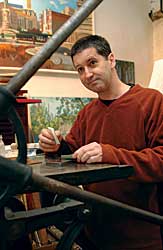On the Money
It’s
no exaggeration to state that every American
owns at least one piece of artwork by William
S. Fleishell III, BA ’89.
In fact, many people have trouble getting
through a day without touching one of his
creations. A journeyman picture engraver
at the U.S. Treasury, Fleishell created the
portrait of President Abraham Lincoln on
the new U.S. $5 bill.

|

Engraver William
S. Fleishell II, BA ’89, in
his Capitol Hill studio. Fleishell
created the portrait of President
Abraham Lincoln on the new U.S.
$5 bill.
Julie Woodford
|
One of only 40 bank note portrait engravers
in the world, Fleishell joined the U.S. Bureau
of Engraving and Printing in 1987, launching
his engraving career with a mandatory 10-year
apprenticeship. The job was a perfect fit for
Fleishell, who has long been a fan of drawing
and painting in the naturalistic style of the
old masters. “My heroes are the 17th
century Dutch painters and engravers,” explains
Fleishell, who thinks of his paintings as “three-dimensional
sculptures.”
Soon after landing the job, he enrolled at
GW to simultaneously complete his degree in
the fine arts. “Right from the start,
I felt like I was at home,” he reflects,
noting that his classmates were “incredibly
talented” and that his professors were
top notch. Prior to attending GW, Fleishell
earned a certificate at the Pennsylvania Academy
of Fine Arts in 1983, where he received awards
for excellence in drawing.
A seventh-generation Washingtonian, Fleishell’s
family has resided in D.C.’s Capitol
Hill/Navy Yard neighborhood since the 1820s. “My
great-great-grandfather was a stone carver
who worked on the Capitol building before the
Lincoln administration, and members of my family
have worked as printers in Washington since
the Civil War,” he says. Fleishell also
follows in the footsteps of his father, a professional
artist whose drawings filled the walls of his
home growing up.
Now a full-fledged journeyman portrait engraver
at the bureau, Fleishell’s group is responsible
for creating official engraved portraits of
every U.S. president. “It’s a ceremonial
thing that we’ve been doing since the
Civil War,” explains Fleishell, who was
chosen to engrave the portrait of President
George W. Bush, as well as the late Supreme
Court Chief Justice William H. Rehnquist. He
also engraved a portrait of George Washington
for the 1997 stamp commemorating the 150th
anniversary of U.S. stamp production, as well
as the border of the new $100 bill.
According to Fleishell, bank note portrait
engravings take at least 300 hours to complete
and are done by hand. A painstaking process,
the engravings are cut into steel with hand
tools and are typically done in miniature. “All
the work is done backwards,” Fleishell
notes, “so you have to think in reverse.” Needless
to say, the pictures are hard to duplicate,
making bank note portraits the primary counterfeit
detector on U.S. currency.
For his portrait of Lincoln, Fleishell used
a series of 1864 photographs of the 16th president
by Anthony Berger as his reference. “I
wanted to capture that faraway, knowing look—that
emotion,” says Fleishell, who spent more
than 400 hours perfecting the engraving. “To
be a good engraver is to be a good interpreter.” For
that reason, Fleishell spends hours researching
his artistic subjects.
Fleishell has a special affinity for Lincoln
because of the strong mark he left on D.C. “He
did a lot to make D.C. what it was after the
Civil War,” he says. Fleishell also notes
that his great-great-grandfather was one of
Lincoln’s guards at his inauguration.
While most of Fleishell’s work is done
behind closed doors, he shares his expertise
with the community whenever he gets the chance.
Several years ago, Fleishell was featured on
the Discovery Channel. “They filmed me
for an entire day at the bureau for a segment
called ‘Inside the World’s Mightiest
Bank,’” he says. He also connects
with the public through periodic teaching gigs,
including a recent seminar at the Rhode Island
School of Design.
Fleishell spends his spare time painting at
his Capitol Hill studio—an old carriage
house south of the Eastern Market. “My
great-grandparents had a store on the same
block as my studio 100 years ago,”
Fleishell notes.
He is heavily involved in “Art on Call,” a
project to spruce up Washington’s 600
old emergency call boxes by creating unique,
site-specific artwork for the historic relics,
which used to house telephones and telegraphs.
Fleishell came up with the idea for the project,
which is now being administered by the D.C.
Heritage and Tourism Coalition. “It’s
a grass roots project that’s very dear
to my heart because it emphasizes the cultural
heritage and hometown aspect of Washington
outside of the national political landscape,” he
says. “The project commemorates the neighborhoods
of D.C. through engaging, colorful plaques
and sculptures depicting famous historic local
events, people, and buildings. Our aim is to
showcase the positive side of the city outside
the murder and mayhem and to make passers by
look twice at the neighborhoods they’re
walking through.”
Through his myriad artistic accomplishments,
Fleishell has achieved success but says that
his greatest career triumph is making people
happy through his work. “Last week, a
woman bought one of my prints and walked away
with the biggest smile on her face,” he
says. “That meant the world to me.”
—Jamie L. Freedman